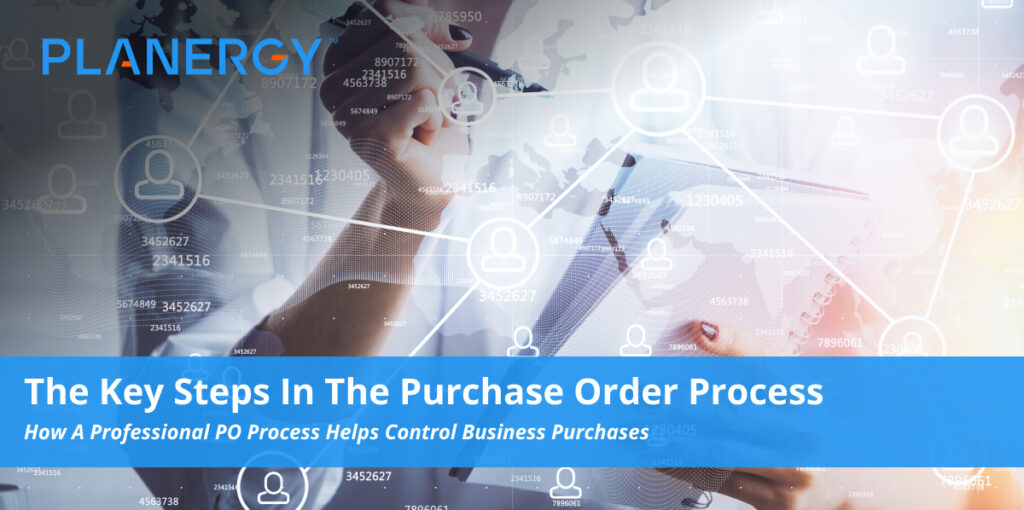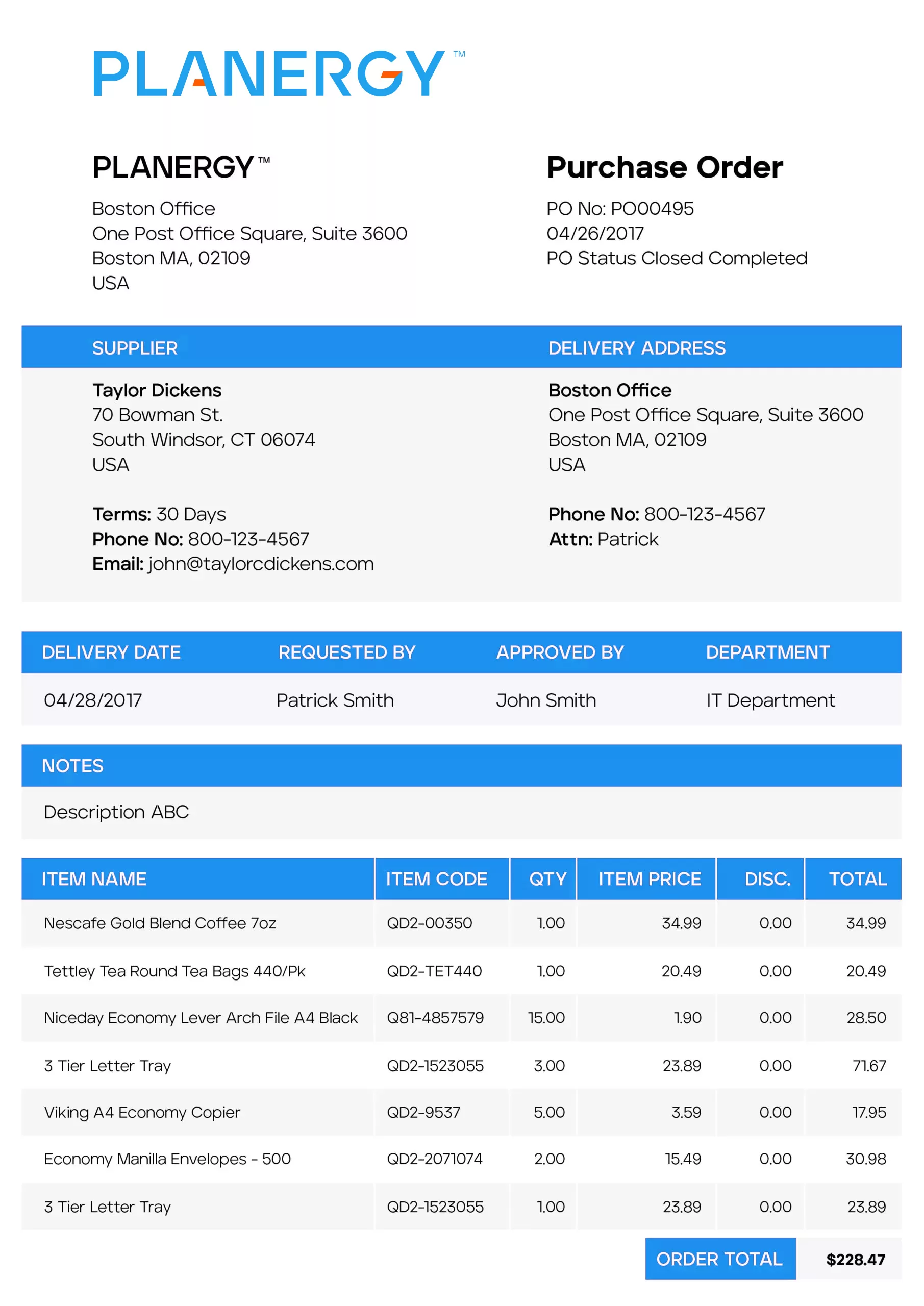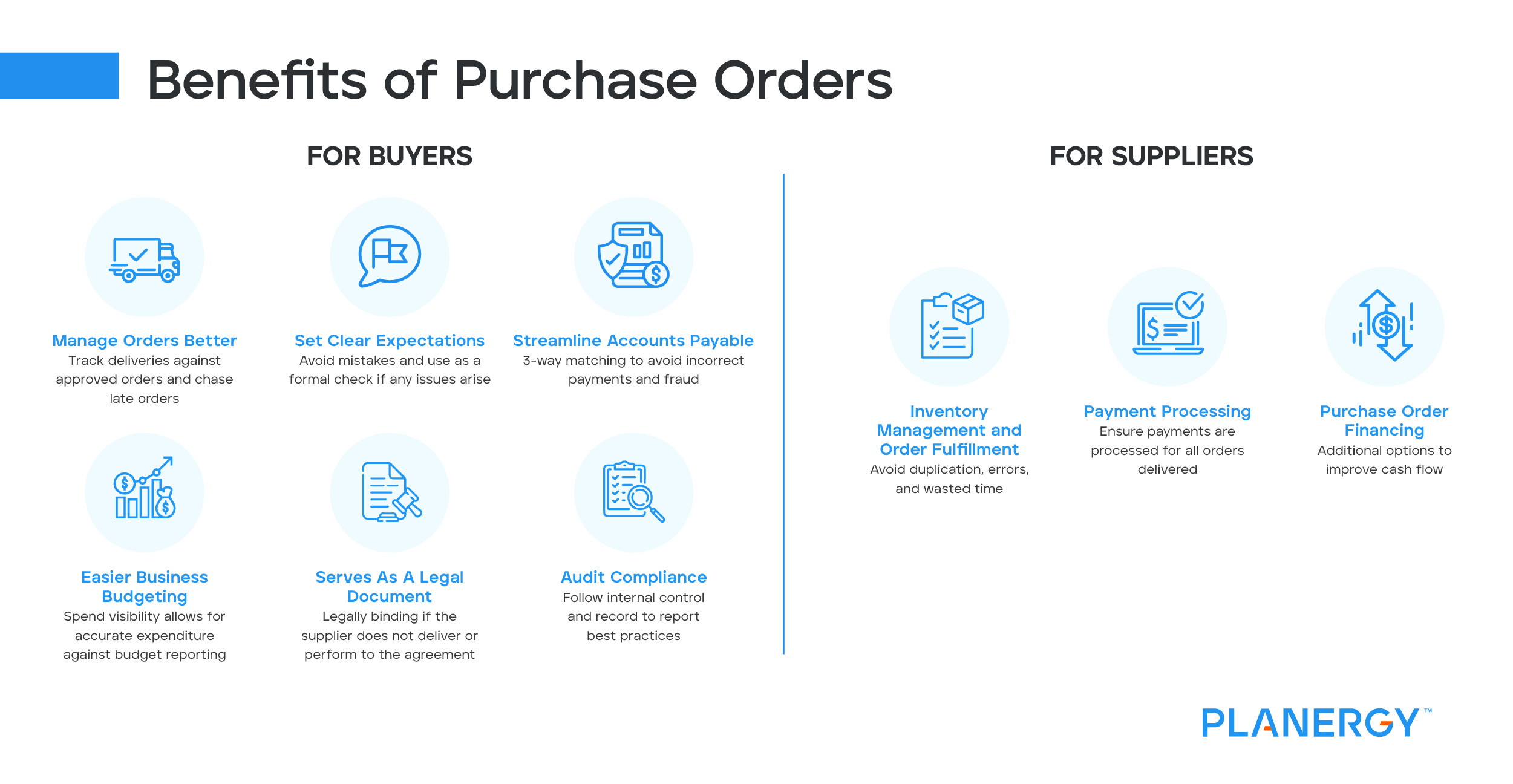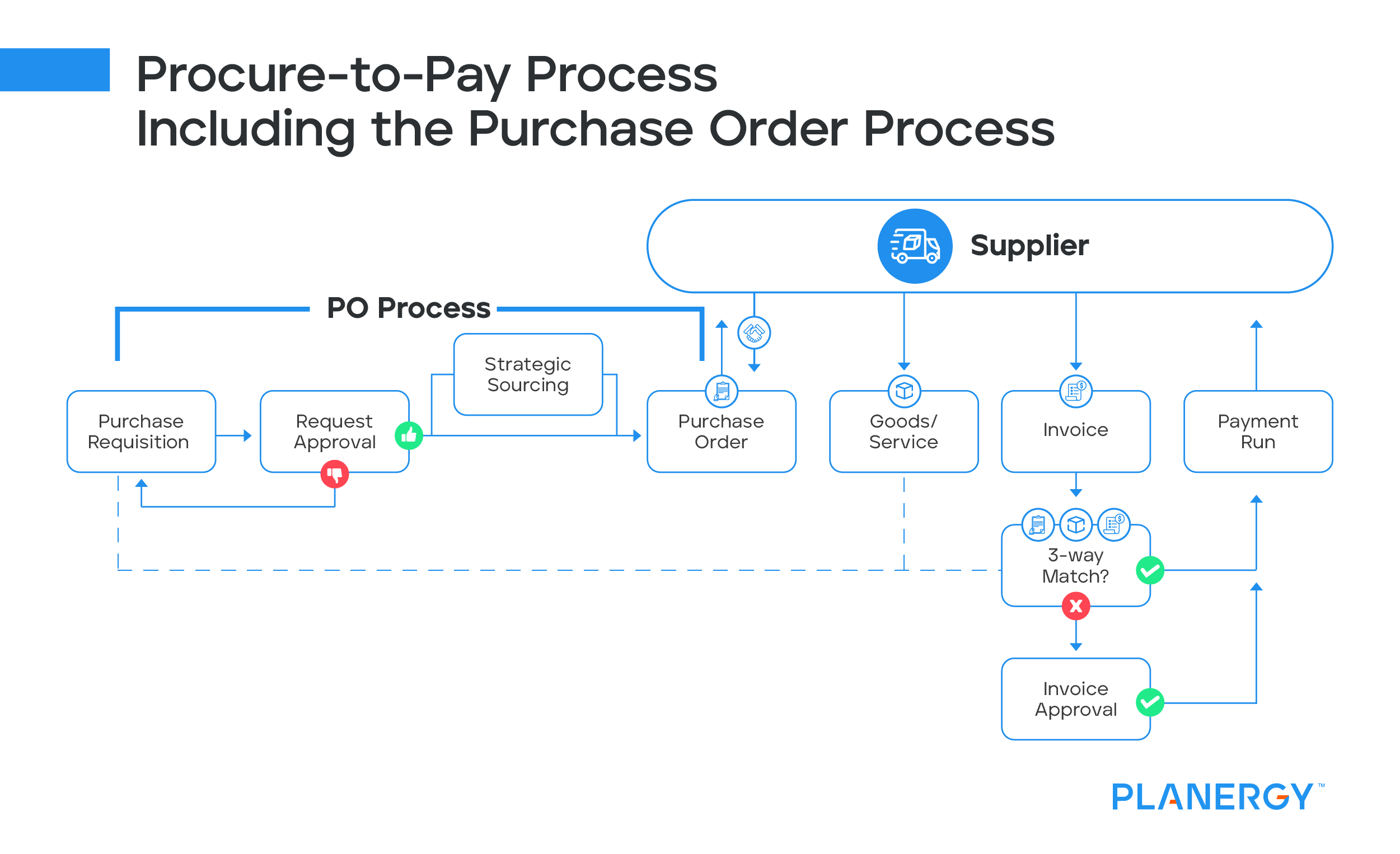Purchase orders (POs) are central to the purchasing process, playing an important role in controlling business purchases.
In this post, we’ll define what a purchase order is, describe what information it includes, highlight key benefits of using POs, and explain the key steps in the purchase order process. But first, let’s start by answering the question ‘what is a purchase order?‘.
What's Planergy?
Modern Spend Management and Accounts Payable software.
Helping organizations spend smarter and more efficiently by automating purchasing and invoice processing.
We saved more than $1 million on our spend in the first year and just recently identified an opportunity to save about $10,000 every month on recurring expenses with Planergy.

Cristian Maradiaga
King Ocean
Download a free copy of "Indirect Spend Guide", to learn:
- Where the best opportunities for savings are in indirect spend.
- How to gain visibility and control of your indirect spend.
- How to report and analyze indirect spend to identify savings opportunities.
- How strategic sourcing, cost management, and cost avoidance strategies can be applied to indirect spend.

IN THIS ARTICLE
- What Is a Purchase Order?
- What Information Does a Purchase Order Include?
- What Are the Benefits of Purchase Orders?
- Do Businesses Always Need Purchase Orders?
- What is the Purchase Order Process?
- What is the Difference Between a Purchase Order and a Purchase Request?
- How is a Purchase Order Different from an Invoice?
- What Are the Responsibilities of the Purchasing Department?
- Why Should You Automate the Purchase Order Process?
What Is a Purchase Order?
A purchase order is the official confirmation of an order sent from a buyer to a seller of goods or services. It is a document sent from a purchaser to a vendor that authorizes a purchase.
What Information Does a Purchase Order Include?
While some information may vary, purchase orders generally include several standard details, including:
- The name of the company purchasing the goods or services
- Order date
- Delivery date
- The description and quantity of the goods or services
- Pricing
- Vendor catalog item numbers
- A mailing address
- Payment terms
- Invoice address
- A purchase order (PO) number

What Are the Benefits of Purchase Orders?
Purchase orders play an essential role for both the buyer and supplier. The following are several benefits of using purchase orders.
Purchase Order Benefits for Buyers
Set Clear Expectations
Purchase orders enable purchasers to clarify their exact needs to vendors. Not only does this help ensure that you get off on the right foot, but both parties use it as a formal check if there are any issues with the order from either the vendor or purchaser’s side.
Manage Orders Better
Many businesses designate certain individuals to manage inventory, which typically includes processing incoming orders. These individuals generally are in procurement, finance, or operations.
Purchase orders give these individuals official documentation of incoming or pending deliveries, enabling them to track and manage orders more effectively. Any orders not delivered in the agreed timeline can be chased up on with the supplier.
Easier Business Budgeting
Once a company creates a purchase order, the purchaser immediately factors these costs into company budgets. Businesses benefit from having clear records of how much money is spent and where it’s going.
Serves as a Legal Document
We are often asked whether a purchase order is a legally binding contract. The answer is now officially a yes. Purchase orders are legal documents, per the 2014 court case, MidAtlantic International Inc. vs. AGC Flat Glass North America Inc.
In this case, a federal court determined that purchase orders are an enforceable contract between two parties. In the absence of a formal contract, a purchase order serves as a legally binding document only after it is accepted by the vendor.
Audit Compliance
Auditors are on the lookout for financial discrepancies. They’ll be particularly interested in goods and services coming in and payments going out. Issuing, processing, and recording purchase orders with full audit trails is a great way to keep auditors happy.
Streamlines Accounts Payable
A PO system helps automate the AP process by giving the finance team visibility of POs and receiving documentation when processing invoces.
This allows for a 3-way match to be followed, greatly reducing the number of invoices that have to be managed as an exception while avoiding incorrect payments due to fraud or human error.
The accounting software is updated automatically, improving accuracy, reducing invoicing costs and time required to approve invoices. Also, it enhances data transparency and improves fraud protection.
Purchase Order Benefits For Suppliers
Inventory Management and Order Fulfillment
Suppliers can use POs to help their inventory management ond order fulfilment process. The items confirmed on the PO need to be taken from inventory and delivered to the buyer.
Having this information documented correctly means they can easily track incoming orders and prevent duplicate orders going out. The quantities can be checked at each stage to help avoid errors during this process that can be costly and time consuming to correct.
Payment Processing
At the end of the fulfilment cycle POs can be matched against outgoing invoices to ensure all fulfilled orders are charged for and payment received. Referencing the PO number on the invoice also generally will speed up processing of invoices by customers resulting in better cash flow management.
Purchase Order Financing
A supplier can also benefit from purchase order financing on the back of their PO order book. As the POs are legally binding agreements to buy credit can be offered against the POs that are still awaiting payment. This can help with improving cash flow.

Do Businesses Always Need Purchase Orders?
Whether businesses need purchase orders depends on several factors, but generally, it’s a good business practice to keep things in order.
In today’s world, communication happens at the speed of light. Orders are made in passing over the phone, via email, and even through texting. Foregoing formal confirmation of an order means that you or your vendor may forget important order details.
Some institutions do not require a purchase order for specific items. We’ll illustrate using the requirements of a small private university listed on its website. POs are not required for the following expenses:
- Interdepartmental charges (bookstore, print room, etc.). These charges are billed monthly instead.
- The reimbursement of travel expenses. The institution uses a check request form instead.
- The renewal of annual memberships and subscriptions. An expense reimbursement request is required instead.
- When ordering office supplies online from the university’s designated supplier.
What is the Purchase Order Process?
The following are the steps in the purchase order process. This process is governed by the company’s internal purchase order policy.
Note that the purchase order process is one part of a broader procurement process that includes everything from identifying the need for a good or service to payment. Read our blog post on the entire procurement process here. Many companies will implement a purchase order system.

Purchaser Creates Purchase Requisition
The purchase order process starts with a purchase requisition. This document is created by the purchaser and submitted to the relevant budget holder that controls finances in the purchase order approval process.
Consider this the part of the process where you get the thumbs up to purchase the goods and services you want. You’re not actually ordering anything – you’re getting the approval to do so. Approvers can choose to approve, reject, or flag your request for further discussion.
The key difference between purchase requisitions and purchase orders is that a purchase requisition is about internal permission, and purchase orders are generally used for external communication with your suppliers.
Read our blog post on purchase requisitions vs. purchase orders for a detailed comparison of these two documents.
Purchase Requisition Is Approved
To become a purchase order the purchase requisition needs to be approved following the requirements outlined in the company’s purchase order policy.
The approval requirements will usually change based on the department or project the purchase relates to and the value of the purchase.
Generally, the higher the value the more people will be required to approve. A purchase requisition will become a purchase order only when all approval requirements have been fulfilled.
Purchaser Issues Purchase Order
Once the required people have approved the purchase requisition, the company issues a purchase order to the vendor.
In essence, POs place the order. Purchase orders are typically created using purchase order software like Planergy, which enable businesses to track POs and submit them electronically.
Vendor Approves, Rejects, or Submits PO for Discussion
The vendor will review the purchase order thoroughly, paying close attention to quantities, prices, the total amount due, delivery due date, and terms and conditions.
Once the vendor approves the purchase order (usually via email or an e-procurement software), they prepare the goods or services to be delivered.
If they do not have an item being bought or other concerns with the order, it is flagged and sent back to the purchaser for further discussion.
Purchaser Records Purchase Order
The final step in the purchase order process consists of the purchaser recording the PO. In a manual PO process this will involve manual filing the purchase orders in preparation for any future audits.
Once these steps in the purchase order process are complete, the goods or services are delivered and inspected. After that, the vendor issues an invoice to the purchaser’s finance team, following best practice, three-way matching of the invoice against the PO and delivery documents, payment is made, and the transaction is complete. This would complete the full Procure-to-Pay process.

What Is the Difference Between a Purchase Order and a Purchase Request?
While they may seem similar, a PO and purchase order request (or purchase requisition) differ significantly. A purchase order is an officicial document submitted to the vendor, outlining the information of the real purchase. On the other hand, a purchase request is a document used by a manager or staff to request internal approval for the purchase of specific goods or services.
Also, while purchase orders carry all the information required to complete a purchase, a purchase order request may only contain basic details.
An approved purchase request should be assigned a PO number to become a PO at the end of the purchase order approval process.
How Is a Purchase Order Different From an Invoice?
While they may seem similar, purchase orders and invoices are quite different. An invoice requests payment for a purchase and is sent from the vendor to the purchaser.
It includes the same information as in the purchase order, an invoice number, vendor contact information, any credits or discounts for early payments, payment schedule, and the total amount due to the vendor.
The key differences between the two documents are that a purchase order prompts the creation of an invoice. It is sent by the purchaser to the vendor, whereas an invoice is sent from the vendor to the purchaser. In addition, the purchase order officially “orders” goods or services from a vendor while the invoice requests payment for the order.
What Are the Responsibilities of the Purchasing Department?
The purchasing department plays an integral role in the purchase order process. It is responsible for issuing purchase order and ensuring that all details indicated in it are accurate. If a preferred supplier has not already been identified for the requested items they may also be involved in sourcing to identify a new supplier.
Why Should You Automate the Purchase Order Process?
The purchase order process is important, but in the absence of a PO system, it is undoubtedly manual and time-consuming. Companies often initially implement a manual purchase order system to manage this – a purchase order form with approval sign-off often by phone or email. This is often coupled with an excel purchase order tracking spreadsheet.
There are many problems with a manual procurement process, including being prone to human error. With a system like Planergy, the entire process becomes more efficient through automation. Here’s why you should automate this process:
Centralized Access to All Purchasing Documents
Referencing purchase requisitions and POs is less bureaucratic with an e-procurement solution that automates auditable record keeping. It allows you to access any of the details you need, whenever you need them – in one place.
Easier Purchase Requisition Process
With automated vendor catalogs, you can create purchase requests using a standardized form online using our computerized vendor catalogs. There is no need to thumb through outdated paper vendor catalogs for goods or services.
Online catalogs make it easy to find the item you’re looking for at the right price from preferred suppliers while reducing manual data entry. You can also store items for greater savings and make purchasing more convenient.
Faster Approvals
Getting purchase requisitions approved is faster and easier with an automated system. You can send them directly to the person who approves them through the system, reducing bottlenecks.
Setting up an approval workflow is as easy as clicking a button. Once that person is designated as the approver, they will instantly begin to receive automated approval requests, which trigger the creation of a purchase order. Approvals can be managed on the go – no more holding up orders.
Create and Share Purchase Orders Easily
Like purchase requisitions, purchase orders are easily managed through e-procurement software. You no longer have to worry about the format for purchase orders because it’s all pre-populated. On top of that, you can send them to vendors in any format.
More Visibility Into Spending
With e-procurement systems, you manage the whole Procure-to-pay (P2P) lifecycle and have access to insights and analytics that help you monitor business expenditure more effectively.
Relevant team members see the impact of purchase requisitions before you approve them, and budgets are automatically updated once a purchase order is sent.
See Order Status at a Glance
Seeing the status of all your orders in one place is a massive benefit to automating the purchase order process. You can easily track important moments in the PO process, like which purchase requisitions have been approved or rejected and which purchase orders have been sent.
Reduce Invoice Approval Cycle Time
The finance department spends less time chasing confirmation when an invoice should be paid and streamline invoicing by matching against approved POs with full visibility on the audit trail. There is no need to trawl through a paper trail when purchase order management is digital!
Better Cash Flow Management
Having real-time visibility of your committed spend from the point of approval, the ability to report on accruals, and the ability to three-way match and authorize invoices more quickly all give your finance team much more flexibility to manage cash flow.

The Purchase Order Process is Important For Your Business
The purchase order process is an important one for businesses. Developing and maintaining a professional PO process is great for building optimal supplier relationships, keeping an audit trail, and sticking to budgets, among other valuable benefits. Automating it helps you streamline communications and minimize financial risk.
What’s your goal today?
1. Use Planergy to manage purchasing and accounts payable
We’ve helped save billions of dollars for our clients through better spend management, process automation in purchasing and finance, and reducing financial risks. To discover how we can help grow your business:- Read our case studies, client success stories, and testimonials.
- Visit our Purchase Order Software page to see how Planergy can digitize and automate your purchase order process saving you time and money.
- Learn about us, and our long history of helping companies just like yours.
2. Download our “Indirect Spend Guide”
Download a free copy of our guide to better manage and make savings on your indirect spend. You’ll also be subscribed to our email newsletter and notified about new articles or if have something interesting to share.3. Learn best practices for purchasing, finance, and more
Browse hundreds of articles, containing an amazing number of useful tools, techniques, and best practices. Many readers tell us they would have paid consultants for the advice in these articles.


